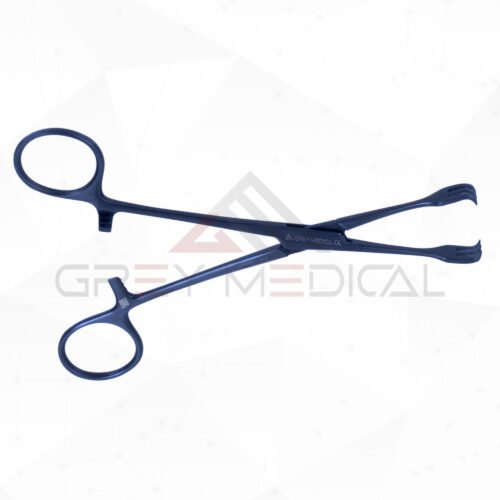Surgical instruments are the unsung heroes of successful medical procedures, and the Lahey Traction Forceps stands out as one of the critical tools in this domain. Known for its precision and reliability, this lahey traction forceps specialty instrument has earned its place in various surgical applications, particularly in the field of general and thyroid surgery.
What Are Lahey Traction Forceps?
Lahey Traction Forceps are specialized instruments designed for gripping and manipulating tissues with exceptional accuracy. Made from high-quality stainless steel to ensure durability and sterility, these forceps are characterized by their long, slender shape and precise, ratcheted grip. The instrument's name is derived from Dr. Frank H. Lahey, a renowned surgeon who introduced innovative techniques in thyroid and general surgery during the 20th century.
This tool is most commonly used in surgeries requiring tissue traction, offering surgeons a greater level of control when dissecting or maneuvering delicate tissues. The design ensures a firm hold without causing excessive damage to the tissue, a critical factor in minimizing complications during surgical interventions.
Key Features of the Lahey Traction Forceps
One of the defining qualities of the Lahey Traction Forceps is its ability to provide both grip and gentleness. Its finely serrated jaws ensure an optimal hold, while its curved or straight configurations allow versatility in different surgical scenarios. The ratchet mechanism ensures that the surgeon can lock the forceps in place, reducing hand fatigue during lengthy procedures. Additionally, modern designs often incorporate ergonomic features, enhancing comfort and usability.
The forceps are predominantly autoclavable, meaning they can be sterilized to high standards. This ensures the prevention of infections and makes the instrument suitable for repeated use in a sterile environment.
Applications in Surgery
Thyroid Surgery
Lahey Traction Forceps play a pivotal role in thyroidectomy procedures. These surgeries require the identification and dissection of delicate structures such as the thyroid gland, parathyroid glands, and associated blood vessels. The forceps enable surgeons to handle glandular and vascular tissues with precision, ensuring minimal trauma to surrounding areas. Particularly, it is used to hold the thyroid gland in place, allowing surgeons a clear, unobstructed view of the operative site.
General Surgery
The instrument is equally valuable in broader general surgical applications. When performing tissue resections or soft-tissue repairs, surgeons rely on the Lahey Traction Forceps to provide a secure grip and aid in retracting tissues. This ensures better access to deeper anatomical structures. Its role in maintaining tissue integrity during clamping and holding operations often proves vital in the success of these procedures.
Oncology and ENT Applications
Oncology surgeries often require methods that protect adjacent healthy tissues, and the Lahey Traction Forceps is particularly useful here. The instrument’s precision supports the careful manipulation of tumor sites. Similarly, in ear, nose, and throat (ENT) surgeries, these forceps are instrumental in managing delicate tissues in confined spaces.
Advantages of Using Lahey Traction Forceps
The continued reliance on Lahey Traction Forceps highlights the multiple advantages it brings to surgical settings. Chief among them is its reliability—a surgeon’s ability to securely grip tissues without slippage significantly improves procedural safety. Its ergonomic design also ensures that surgeons can perform intricate procedures without unnecessary strain or fatigue, allowing for sustained concentration during lengthy operations.
Additionally, the instrument’s ability to minimize tissue damage is invaluable, particularly in reducing post-operative complications such as infections and delayed healing. This attribute aligns with the growing focus on patient safety and the drive toward minimally invasive surgical techniques.
Maintenance and Care
To sustain the instrument’s functionality, proper care and maintenance are imperative. Lahey Traction Forceps are made to resist corrosion and wear, but regular sterilization through autoclaving is essential to maintain the highest hygiene standards. Routine inspection for any signs of wear or damage is also necessary to ensure that the forceps remain precise and effective.
The Role of Lahey Traction Forceps in Modern Medicine
The Lahey Traction Forceps exemplifies the innovation and meticulous design that characterize modern surgical instruments. Its contributions to key medical fields such as general and thyroid surgery have made it a trusted tool used by surgeons worldwide. By enabling precise tissue handling, it minimizes risks and promotes favorable surgical outcomes.
Conclusion
The Lahey Traction Forceps continues to play a foundational role in the surgical toolkit. Its reliability, versatility, and precision make it indispensable for procedures that demand the highest level of accuracy and care. Whether in thyroid surgeries, general procedures, or specialized fields like oncology, this instrument consistently rises to the challenge. Proper maintenance and handling further ensure its longevity as a trusted companion in operating rooms. For surgeons aiming to provide the best patient care, the Lahey Traction Forceps is a tool that delivers consistent results and enhances surgical performance.





Comments